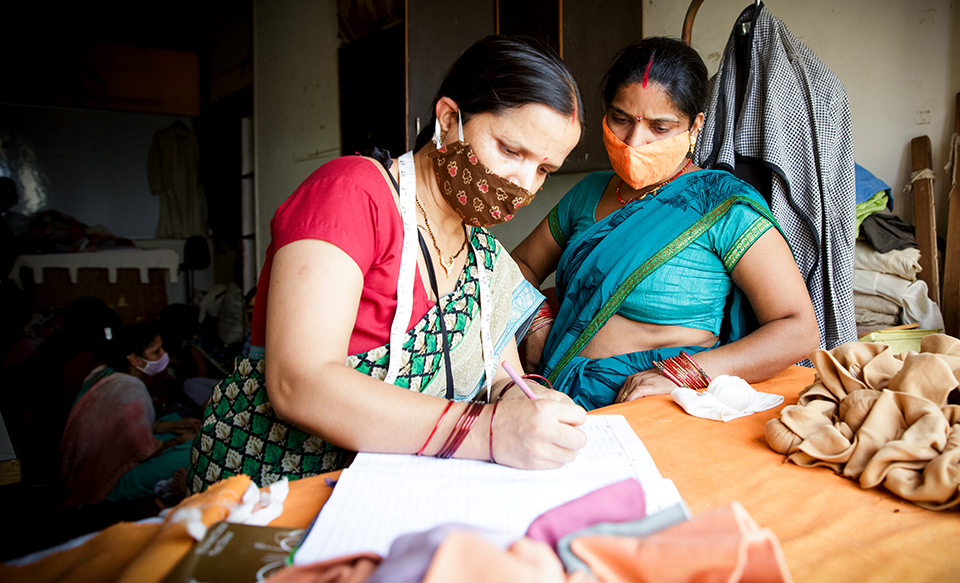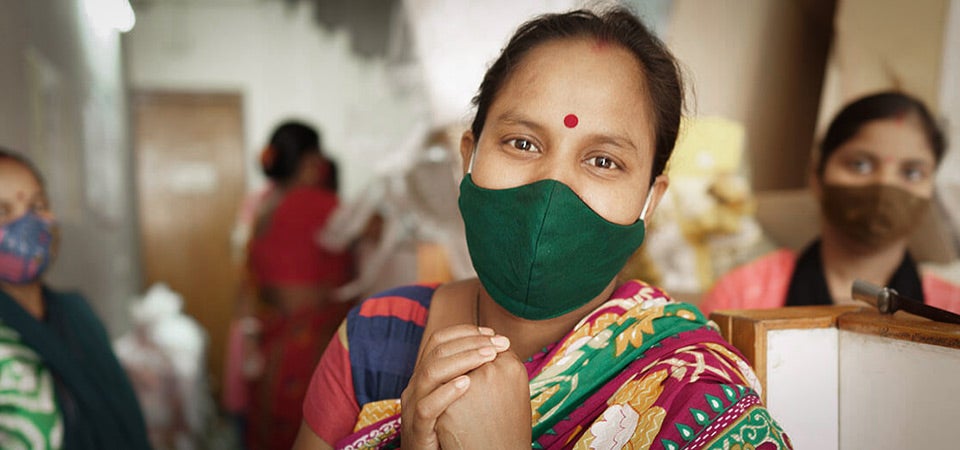Overview: In South Asia, COVID-19 deepens gender disparities
Date:
Authors: Gizem Yarbil Gurol, Gretchen Luchsinger



A new wave of COVID-19 cases has severely strained health systems and communities across South Asia. Women play indispensable roles in the response but also face dire consequences. They have lost more jobs than men, struggle with care work burdens, and confront increased gender-based violence.


In recent months, South Asia has had some of the highest numbers of COVID-19 cases globally, driven predominantly by the second wave of the pandemic in India and Nepal. Since January 2020, India has reported over 30 million cases and more than 400,000 fatalities, figures that are likely substantially underestimated. Cases in Nepal rapidly spiked in mid-April 2021, with over 635,000[i] confirmed cases by the end of June and at least 9,000 deaths.[ii] Both countries have seen critical gaps in life-saving vaccines, treatment and tests, and in skilled human resources.
For vulnerable and marginalized groups – especially poor women and girls, gender and ethnic minorities, women and girls with disabilities— the crisis has deepened pre-existing inequalities, and the fallouts have been severe. Thousands of women and girls have lost livelihoods and are unable to meet essential needs such as food, health care and personal protective equipment. They also need specific and long-term support to return to the workforce. Further, the failure to classify certain medical services as “essential” during lockdowns has added pressures by preventing people with HIV from continuing antiretroviral therapy and leaving trans people without hormone therapy. Measures restricting mobility have meant persons with disabilities cannot access critical services.
The path to recovery from COVID-19 in South Asia starts with understanding and meeting the varying needs of women, girls and gender minorities.
Economic downturn takes a profound toll on women

In every crisis, women and girls, especially those from poor and marginalized communities, are among the most affected. During the COVID-19 pandemic they have experienced increasing fear, disease, mental stress, hunger and loss of livelihoods.
Women who are daily wage earners, small business owners and working informal jobs have lost ground in large numbers during the pandemic. A recent report by the Center for Sustainable Employment at Azim Premji University in India found that during the first lockdown in 2020, 61 per cent of working men remained employed and 7 per cent lost employment. Yet only 19 per cent of working women kept their jobs and 47 per cent suffered a permanent job loss, not returning to work even by the end of the year. These grim statistics only cover formal employment. More than 90 per cent of women in India and Nepal[iii] labour in informal and home-based jobs, which have been even more devastated by the pandemic. Rural women in India, many in informal jobs, accounted for 80 per cent of job losses between March and April 2021[iv]. Some 6 million farmers in India lost employment from March to April 2021 alone, and 75 per cent of women workers are in agriculture, compared to 55 per cent of male workers.[v]
In Nepal, women typically work in jobs where telecommuting is not possible, such as in the hospitality sector, and wholesale and retail services. A gender assessment covering all provinces in Nepal found that 28 per cent of men lost their jobs during the lockdown, compared to 41 per cent of women. Gender pay gaps compound the inequality. For every 100 rupees that a man earns in Nepal, a woman takes home only 70 rupees. For women, job losses often mean lower income as well as a reduction in agency and empowerment at home and in society[vi].
Many women may not return to employment because of heavier burdens of unpaid care work, economic slowdowns, lack of access to financing for female entrepreneurs, and domestic violence. In India, the already disproportionate amount of time women spend on family responsibilities increased by nearly 30 per cent. More than 74 per cent of women in Nepal reported an increase in unpaid domestic and care work during the lockdown.[vii]
Gender-based violence intensifies, with little recourse
Gender-based violence has soared in South Asia during the pandemic, as it typically does in crises[viii]. In Nepal, data from the police, National Women’s Commission and rapid gender assessments[ix] have indicated rising intimate partner violence, including marital rape, domestic violence and other forms[x]. Since the first lockdown in March 2020, a total[xi] of 1,669 domestic violence cases and 353 cases of other forms of violence against women have been reported through the 1145 toll-free helpline for survivors.[xii] Survivors were also unable to access timely and quality response services.[xiii]
A study by the Women’s Rehabilitation Center (WOREC) Nepal found that 75 per cent of respondents believed that domestic violence could happen during lockdowns, while 64.7 per cent indicated that there is nowhere to go to lodge a complaint.[xiv] A Forum for Women, Law and Development (FWLD) report on the first lockdown found law enforcement personnel emphasizing reconciliation rather than filing complaints of domestic violence, and were reluctant in registering sexual violence cases.[xv] Despite sustained advocacy in Nepal, services to respond to gender-based violence have not been classified as essential.
Both India and Nepal have also seen a sharp spike in other crimes against women and girls, such as child marriage, cyber violence and trafficking.[xvi] In India, around 700 One-Stop-Crisis centres have remained during COVID-19, supporting over 300,000 women facing violence and abuse.[xvii]
Women lead the pandemic response, but overlooked in decision-making

Amid many hardships, South Asian women continue the fight against COVID-19 on the front lines as health-care workers, social mobilizers and caregivers. This puts many at a higher risk of infection. More than 66 per cent of Nepal’s health workers are women, who make up 33 per cent of medical doctors and an overwhelming 99 per cent of nursing personnel.[xviii] In India, women make up 47.2 per cent of all health-care workers and almost 89 per cent of nurses and midwives.[xix]
With only 1 doctor for every 1,000 people in India and every 1,335 [xx] in Nepal, the burden of care for sick and vulnerable family members falls largely on women, putting them at risk of infection and increasing already exhausting unpaid care load.
In the most remote, rural parts of India, communities have become completely reliant on an all-female health-care force called ASHA (accredited social health activist). Nepal’s rural areas rely on an extensive network of 51,416 female community health volunteers for reproductive and maternal health, family planning and child health services.[xxi]
However, despite their vital roles in responding to COVID-19, women rarely lead or even take part in national or global decision-making on the pandemic. In India, only 13 per cent of the members of the national COVID-19 task force are women.[xxii] Nepal has no women on the Government’s seven-member COVID-19 Crisis Management Centre.[xxiii]
“Whether it’s at home, in the office or in the field, we must stop taking women’s work for granted,” says UN Women Country Representative Susan Ferguson. Read more
It is possible to recover and build back better from the crisis in South Asia, but it will take investment in policies that value and redistribute domestic and care work, create pathways of education and employment for women, reduce the gender wage gap and address gender-based violence.
Donate to UN Women to support women and girls in South Asia today.
- CoVid19-Dashboard (mohp.gov.np).
- CoVid19-Dashboard (mohp.gov.np).
- Rapid Assessment of Socio Economic Impact of COVID19 in Nepal, UNDP, July 2020.
- M. Nikore (2021). Will India’s second wave shatter hopes of a V-shaped economic recovery?
- Based on the 2017-2018 Periodic Labour Force Survey.
- Rapid Assessment of Socio Economic Impact of COVID19 in Nepal, UNDP, July 2020.
- Surveys show that COVID-19 has gendered effects in Asia and the Pacific, UN Women Data Hub.
- Gender-based violence and COVID-19, UNDP.
- A Rapid Gender Analysis on COVID-19 Nepal 2020, Care Nepal, Save the Children, and Ministry of Women Children and Senior Citizens.
- A Rapid Gender Analysis on COVID-19 Nepal 2020, Care Nepal, Save the Children, and Ministry of Women Children and Senior Citizens.
- A total of 604 cases were received during the lockdown from 24 March to 23 May 2020. The report on the lockdown period until March 2021 was received from a National Women’s Commission official by phone.
- Activities carried out by National Women’s Commission to address violence against women during the lockdown caused by COVID-19 pandemic.
- A Rapid Gender Analysis on COVID-19 Nepal 2020, Care Nepal, Save the Children, and Ministry of Women Children and Senior Citizens.
- Preventive Measures Of Gender-Based Violence During Lock-Down Period Of COVID-19, WOREC Nepal.
- Legal Helpline Service Factsheet, FWLD.
- WOREC Nepal.
- FWLD e-bulletin, January-March 2021.
- Gender Equality Update 25: COVID-19 and Harmful Practices in Nepal, December 2020.
- A Rapid Gender Analysis on COVID-19 Nepal 2020, Care Nepal, Save the Children, and Ministry of Women Children and Senior Citizens.
- Nepal Police, Women, Children and Senior Citizen Directorate.
- Forum for Women, Law and Development.
- B. Kamdar (2021). Addressing Gendered Burdens in India During COVID-19.
- Over 3 Lakh Women Provided Assistance Through 701 One Stop Centres in 35 States/UTs, Government of India.
- Global Health Observatory data repository, Sex distribution of health workers, WHO.
- (NSSO, 2011-12)
- Global Health Observatory data repository, Medical doctors, WHO.
- Female Community Health Programme
- COVID-19 Global Gender Response Tracker.
- COVID-19 Crisis Management Centre, Government of Nepal.
